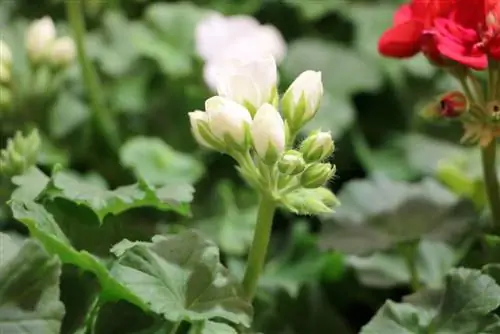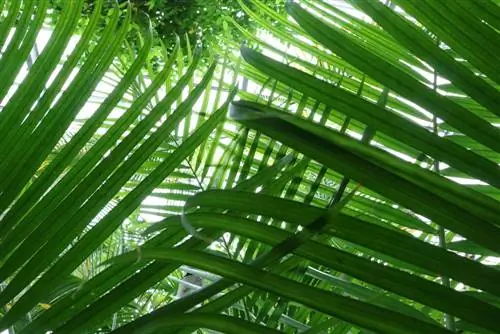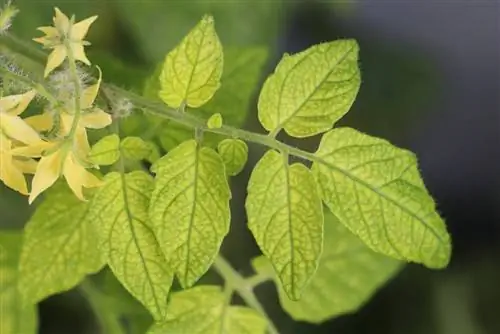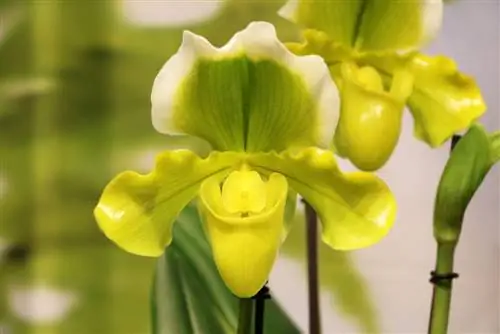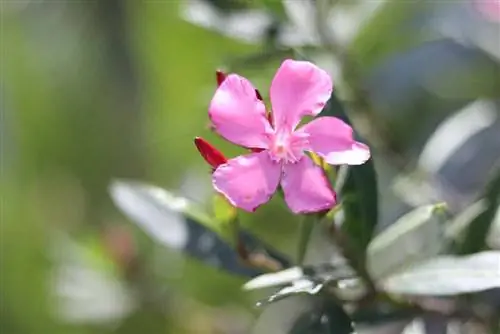- Author admin [email protected].
- Public 2023-12-17 03:39.
- Last modified 2025-01-24 12:45.
Geraniums are hungry plants; These heavy feeders need a lot of fertilizer to develop magnificent foliage and flowers. It is rather doubtful whether it necessarily has to be geranium fertilizer or whether the best geranium fertilizers can be found among the special “geranium fertilizers”. What is certain, however, is that there are numerous home remedies that contain plant-nourishing ingredients and are better used for fertilizing than ending up in the trash can.
What fertilizer do geraniums need?
The same as all land plants that photosynthesize:
The core elements of organic matter are essential for life on land plants; Carbon, hydrogen, oxygen, nitrogen and phosphorus, which are therefore also called core nutrient elements. These core nutrient elements can usually be processed in different chemical bonding forms; Nitrogen e.g. B. is metabolized as nitrate, ammonium or amino acid, which is why it can be supplied via many different organic substances.
The other main nutrients that must be available in more than tiny quantities are potassium, sulfur, calcium and magnesium. In addition, a number of micronutrient elements are essential (absolutely necessary) for land plants, but only in very small quantities: boron, chlorine, iron, copper, manganese, molybdenum, zinc; for higher plants (which include all our balcony and garden plants apart from mosses) also cob alt and nickel.
Today we know about 70 additional elements that normally occur in the natural environment of a land plant but are considered dispensable for plant nutrition. It's just not entirely certain whether science has "completed its research" in this regard - when it comes to human nutrition, at the very beginning only protein, fat and carbohydrates were considered essential, today almost 50 vitamins/vitaminoids, minerals, Trace elements, fatty acids and amino acids are known that humans need for life.
The geranium absorbs its nutrients through air, water and soil; What is not sufficiently represented in this intake must be supplied by humans.
Tip:
Geraniums originally come from South Africa, where the soil does not contain fundamentally different nutrients than ours, but where heat and sun are somewhat more available. A crucial factor in successful geranium cultivation is that the geraniums get enough sun; Well-built south-facing balconies can certainly achieve a microclimate that is quite close to the climate in South Africa. In specialized geranium nurseries you can get Pelargonium varieties that develop a we alth of flowers even in partial shade (also in the mass market, but we are not sure that this is true), but this partial shade should not be the “darkest partial shade”.
The best geranium fertilizers
Nutritional elements that cultivated plants cannot obtain from the soil, air or water are supplied to these plants by humans; This process is called “fertilizing”.

Plants can be put into a chemical formula in terms of the core elements; the typical biomass of a plant is composed on average as follows:C106H180O45N16P1.
The plant prefers to absorb the supply of core nutrients in the same proportions: 106 molecules of carbon, 180 molecules of hydrogen, 45 molecules of oxygen, 16 molecules of nitrogen and 1 molecule of phosphorus. Plants growing in the wild can obtain sufficient amounts of carbon from carbon dioxide in the air, oxygen and hydrogen are also available (in the form of rain) from the air, and nitrogen (in the form of nitrate and ammonium) and phosphorus are obtained from the soil and extracted from groundwater.
In the wild, “the ridiculous one percent” phosphorus is often the minimizing growth factor, because phosphorus usually only occurs in low concentrations and tends to form poorly soluble compounds that plants cannot cleave under all possible conditions. Plants absorb phosphates with their entire roots because they need them so urgently; However, deficiency symptoms occur when the soil has a pH value that is too high (from pH 7 onwards, the plant can hardly absorb phosphorus and insoluble phosphorus compounds form in the soil). Things also get tight when soils are rich in iron and zinc, when soils are too acidic, and when phosphorus is fixed in the soil by other chemical compounds.
In intensive plant cultivation, nitrogen and potassium are the next substances that statistically need to be “topped up” first - this is the reason why you buy NPK fertilizer in the store; Fertilizer with N like nitrogen or nitrogen, P like phosphorus and K like potassium. There is also a long history of experience with regard to the mineral supply of plants as to which minerals are usually missing; These are the trace elements with which all fertilizers are actually enriched and which are sometimes specifically advertised on the packaging.
Now not all plants have exactly the same nutrient requirements, but heavy feeders consume e.g. B. more nitrogen than others, flowering plants need a lot of phosphorus, woody plants need enough potassium (especially in winter) to allow the shoots to mature well and to withstand the cold, and so on.
For the most important plants used by humans for food or ornamentation, there has of course long been empirical data (and more recently scientific studies) as to what the ideal nutrient composition should look like. When it comes to geraniums (which are heavy feeders), for example: B. assume that a fertilizer with approximately the following composition will best help them to grow splendidly: 7.5-10% (3-4 parts) N, 2.5-5% (1-2 parts) P, 7. 5-10% (3-4 parts) K, a little magnesium and trace elements (boron, iron, copper, manganese, molybdenum and zinc).
Professional fertilizers in such a composition are called e.g. B. Tardit or Osmocote long-term balcony flower fertilizer and are applied to the balcony geraniums, which are grown in a flash for mass trade. Some geranium fertilizers are sold in the garden center, here are a few examples with the respective content of main nutrients:
- Compo geranium fertilizer: NPK 8/6/6 with trace nutrients
- Combiflor geranium fertilizer: NPK 5/7/7 with trace nutrients (which are broken down individually)
- Neudorff Bio Trissol geranium fertilizer: NPK 3/1, 3-1, 6/4, 5-5, 8 (there is no mention of mineral nutrients)
- Kölle’s best geranium fertilizer: NPK 4/4/6 (+0.02 iron), with trace nutrients
- Green24 Profi-Line geranium fertilizer pelargonium liquid fertilizer high-tech: NPK 4/6/9 with trace nutrients
- Mairol geranium fertilizer Geranium shine: NPK 3/7/10 with trace nutrients
- terrasan geranium fertilizer liquid fertilizer: NPK fertilizer solution 8/3/5 with trace nutrients
- Cuxin geranium fertilizer liquid: NPK fertilizer 5/6/8
Even these few examples show such an astonishing range in the NPK ratio that only researchers will continue the search for the best geranium fertilizer, while the normal consumer begins to doubt the usefulness of the special fertilizers in the garden center.
But these geranium fertilizers are never the best fertilizers for many geranium growers and lovers because they only give their plants fast-acting mineral fertilizers in emergencies. The organic fertilizers, which act slowly through degradation by soil organisms, can also be specified with an NPK ratio, but this is relatively meaningless given the mechanisms of action of these fertilizers. Every gardener develops their own routines about which plants need what and when. With each adjustment depending on the appearance of the plant, where all of the home remedies listed can be used.
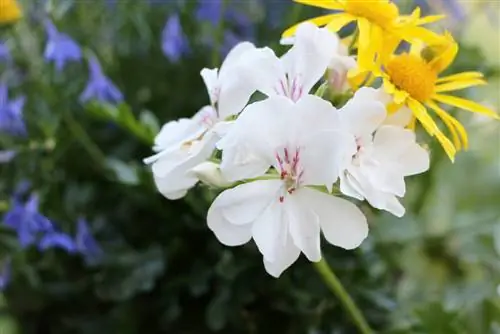
A good start for geraniums would be a balcony box that was set up in autumn with layers of soil between which chicken manure or horn shavings were mixed. After the soil has been allowed to mature until spring, it is watered with diluted nettle manure; later there are effective microorganisms and organic long-term fertilizer. And maybe a sip of mineral fertilizer if the geraniums visibly need strength - or a colorful mixture of everything that is now listed:
Fertilizing with home remedies
The “home remedies for fertilization” are less about home remedies in the usual sense, i.e. H. Clever repurposing of household equipment as a replacement for special tools or for purposes other than its intended purpose. It's about resources and substances that are constantly generated in the house or household and are usually disposed of in the trash can. Many of these substances contain nutrients that can be used by plants; their use as fertilizer saves you from having to buy many packages of ready-made fertilizer:
Aquarium Water (from freshwater aquariums) contains food residues and the remains of the fish and therefore a lot of potassium and nitrogen, which can benefit the plants after changing the water instead of in the water drain to disappear.
Aspirin is said to make plants grow because it was originally extracted from willow and willow water has been proven to promote growth. But it does this with phytohormones such as gibberellic acid, while the acetylsalicylic acid for aspirin is purely chemically synthesized by humans and should probably be used against headaches and not as a (very expensive) flower fertilizer.
Baker's yeast (which dried up in the fridge before it was time to bake cakes) dissolved in a bucket of water allows plants to grow and, enriched with a little sugar, accelerates rotting in the compost. In addition to carbon, oxygen and hydrogen, which are always available to plants in air, water and soil, plants need 15 essential substances, of which yeast contains over half.
Banana peels contain potassium, phosphorus, magnesium and enrich any potting soil when dried and crushed. However, they should come from organically grown bananas; the pesticide cocktail on the peel of conventionally grown bananas could even harm the geraniums.
Beer also nourishes plants excellently, the tendons from the last party can be poured directly onto the geraniums (if you don't celebrate more than once a week).
Cola With its amounts of sugar and phosphorus it contains, it is probably he althier for plants than for us, but it acidifies the substrate if it is disposed of too often in the geraniums.
Eggshells contain 97% calcium carbonate, 2-3% magnesium carbonate, a few proteins and minerals and therefore enrich too acidic substrate for the lime-loving geraniums a little better than the lime from the Garden center.
Egg water Dissolves a little calcium, carbon and oxygen from the breakfast egg, which are better stored in the geranium substrate than in the sink.
Vegetable cooking water contains vitamins and minerals that should at least benefit the geraniums if the water is not used by humans.
Hair can be used at least as well as a nitrogen-rich fertilizer as horn shavings, for geraniums and other heavy feeders.
Wood ash brings geraniums potassium, protection against fungi and a welcome little alkaline boost when scattered from the cooled fireplace or grill onto the plant substrate.
Chicken manure contains nitrogen and trace elements that geraniums love.
Coffee grounds has an average of 2% nitrogen, 0.4% phosphorus and 0.8% potassium, this NPK ratio of 20:4:8 comes down to potassium very close to the perfect geranium fertilizer. The acidifying effect can be neutralized immediately if the eggshells from breakfast are crushed and incorporated into the substrate.
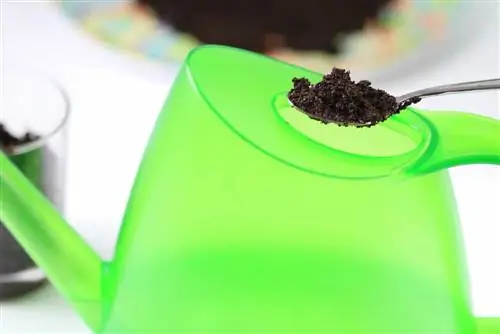
Potato water passes the nutrients washed out of the potatoes on to the geraniums.
Rabbit manure gives the geraniums a strong nitrogen boost and should therefore not be administered too often.
Bone meal is sold in garden centers as fertilizer, but can also be obtained from the soup bones.
Dog poop Unfortunately, the dog poop composter does not make the perfect geranium fertilizer, but at least it is disposed of in an environmentally friendly way
Milk not only repels mildew, but also contains minerals, good microorganisms and a little urea (one of the most important nitrogen suppliers in commercial fertilizer).
Mineral water is called that because it contains minerals, for people and for flowers.
Nails Fingernails and toenails are a little more similar to the horn shavings mentioned with hair.
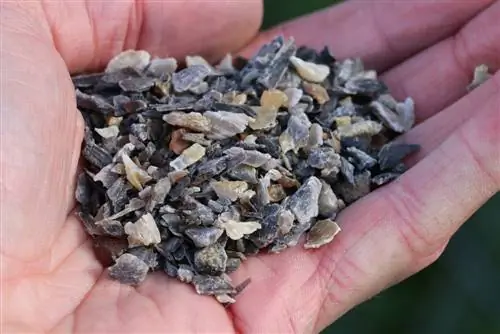
Soda lowers the pH value, which is sometimes good for geranium substrate.
Tea leaves contain similar ingredients to coffee grounds, just in a lower concentration.
Urine would be a great nitrogen fertilizer for geraniums if it wasn't out of place on the balcony.
Cigarette ash In small quantities, ensures lush blooms.
The advantage of “fertilizing with everything”
Which fertilizer is generally missing from the soil would actually have to be determined through soil analysis. Gardeners “who are serious about fertilizing” therefore have such an analysis carried out for the garden soil (when they set up/take over the garden, then every few years) and then fertilize accordingly. In the natural garden, they also like to fertilize with all the nutrient-containing substances just presented, because the nutrients contained in the “household resources” usually first have to be broken down by microorganisms.
Such fertilizers nourish plants sustainably; The risk of over-fertilization, which lurks primarily in the readily available nitrogen compounds in mineral fertilizers, is largely ruled out (however, some home remedies such as concentrated chicken manure also contain such a large portion of nitrogen that they should be applied with caution). When it comes to mineral supply, home remedies offer even more variety; the colorful mix of minerals contained in the various substances probably supplies the plants better with micronutrient elements than any pre-prepared trace element mix.
Balcony gardeners can sometimes resort to soil analyzes if they can get their substrate from the garden (garden soil with loosening substances such as coarse sand or perlite becomes the perfect soil for balcony plants). Balcony gardeners without (access to a) garden rely on pre-fertilized substrate, which would actually be great if the substrate packages were provided with meaningful information about the nutrient content. But that is not always the case, and if nutritional information can be found, it does not necessarily have to be correct - here is a comprehensive test on the subject, the statements of which are unfortunately not refuted by more recent tests: www.test.de/Blumenerde-Die-Wundertueten- 1167574-2167574. If the nutrient content is difficult to determine anyway, as a balcony gardener you can also experiment with the home remedies listed above.
Conclusion
Fertilizing with household waste is part of a “realizable utopia”: a household in which there is hardly any waste and particularly problematic substances, and certainly no poisons. That's possible, and changing your mindset (" I don't have to throw this thing/substance in the trash because a company wants me to believe that it's garbage, but I can and may use it to my advantage") is more difficult than the actual doing. This rethinking is not only good for the planet, but also good for people, because rethinking towards self-determination means a good deal more freedom - and because all leftovers, for example. B. can be used as fertilizer, which saves a lot of money.

